
The history of painting reaches back in time to artifacts and artwork created by pre-historic artists, and spans all cultures. It represents a continuous, though periodically disrupted, tradition from Antiquity. Across cultures, continents, and millennia, the history of painting consists of an ongoing river of creativity that continues into the 21st century. Until the early 20th century it relied primarily on representational, religious and classical motifs, after which time more purely abstract and conceptual approaches gained favor.
Abstract expressionism in the United States emerged as a distinct art movement in the immediate aftermath of World War II and gained mainstream acceptance in the 1950s, a shift from the American social realism of the 1930s influenced by the Great Depression and Mexican muralists. The term was first applied to American art in 1946 by the art critic Robert Coates. Key figures in the New York School, which was the center of this movement, included such artists as Arshile Gorky, Jackson Pollock, Franz Kline, Mark Rothko, Norman Lewis, Willem de Kooning, Adolph Gottlieb, Clyfford Still, Robert Motherwell, Theodoros Stamos and Lee Krasner among others.

Abstract art uses visual language of shape, form, color and line to create a composition which may exist with a degree of independence from visual references in the world. Abstract art, non-figurative art, non-objective art, and non-representational art are all closely related terms. They have similar, but perhaps not identical, meanings.

Lenore "Lee" Krasner was an American painter and visual artist active primarily in New York whose work has been associated with the Abstract Expressionist movement. She received her early academic training at the Women's Art School of Cooper Union, and the National Academy of Design from 1928 to 1932. Krasner's exposure to Post-Impressionism at the newly opened Museum of Modern Art in 1929 led to a sustained interest in modern art. In 1937, she enrolled in classes taught by Hans Hofmann, which led her to integrate influences of Cubism into her paintings. During the Great Depression, Krasner joined the Works Progress Administration's Federal Art Project, transitioning to war propaganda artworks during the War Services era.

Franz Kline was an American painter. He is associated with the Abstract Expressionist movement of the 1940s and 1950s. Kline, along with other action painters like Jackson Pollock, Willem de Kooning, Robert Motherwell, John Ferren, and Lee Krasner, as well as local poets, dancers, and musicians came to be known as the informal group, the New York School. Although he explored the same innovations to painting as the other artists in this group, Kline's work is distinct in itself and has been revered since the 1950s.

Color field painting is a style of abstract painting that emerged in New York City during the 1940s and 1950s. It was inspired by European modernism and closely related to abstract expressionism, while many of its notable early proponents were among the pioneering abstract expressionists. Color field is characterized primarily by large fields of flat, solid color spread across or stained into the canvas creating areas of unbroken surface and a flat picture plane. The movement places less emphasis on gesture, brushstrokes and action in favor of an overall consistency of form and process. In color field painting "color is freed from objective context and becomes the subject in itself."
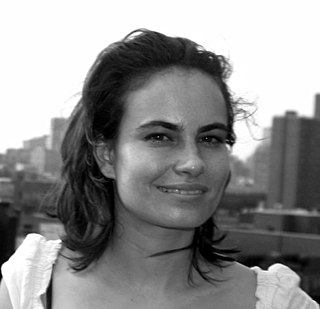
Inka Essenhigh is an American painter based in New York City. Throughout her career, Essenhigh has had solo exhibitions at galleries such as Deitch Projects, Mary Boone Gallery, 303 Gallery, Stefan Stux Gallery, and Jacob Lewis Gallery in New York, Kotaro Nukaga, Tomio Koyama Gallery in Tokyo, and Il Capricorno in Venice.

Amy Sillman is a New York-based visual artist, known for process-based paintings that move between abstraction and figuration, and engage nontraditional media including animation, zines and installation. Her work draws upon art historical tropes, particularly postwar American gestural painting, as both influences and foils; she engages feminist critiques of the discourses of mastery, genius and power in order to introduce qualities such as humor, awkwardness, self-deprecation, affect and doubt into her practice. Profiles in The New York Times, ARTnews, Frieze, and Interview, characterize Sillman as championing "the relevance of painting" and "a reinvigorated mode of abstraction reclaiming the potency of active brushwork and visible gestures." Critic Phyllis Tuchman described Sillman as "an inventive abstractionist" whose "messy, multivalent, lively" art "reframes long-held notions regarding the look and emotional character of abstraction."

Katherine Bradford, née Houston, is an American artist based in New York City, known for figurative paintings, particularly of swimmers, that critics describe as simultaneously representational, abstract and metaphorical. She began her art career relatively late and has received her widest recognition in her seventies. Critic John Yau characterizes her work as independent of canon or genre dictates, open-ended in terms of process, and quirky in its humor and interior logic.
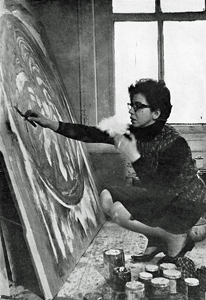
Sonia Gechtoff was an American abstract expressionist painter. Her primary medium was painting, but she also created drawings and prints.

Tomie Ohtake was a Japanese Brazilian visual artist. Her work includes paintings, prints and sculptures. She was one of the main representatives of informal abstractionism in Brazil.
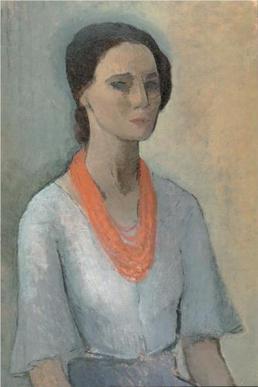
Beatrice "Bice" Lazzari was an Italian painter.
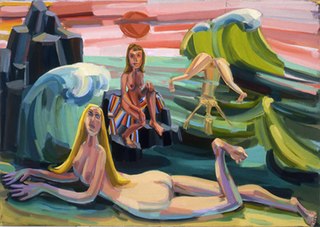
Judith Linhares is an American painter, known for her vibrant, expressive figurative and narrative paintings. She came of age and gained recognition in the Bay Area culture of the 1960s and 1970s and has been based in New York City since 1980. Curator Marcia Tucker featured her in the influential New Museum show, "'Bad' Painting" (1978), and in the 1984 Venice Biennale show, "Paradise Lost/Paradise Regained: American Visions of the New Decade." Linhares synthesizes influences including Expressionism, Bay Area Figuration, Mexican modern art and second-wave feminism, in work that flirts with abstraction and balances visionary personal imagery, expressive intensity, and pictorial rigor. Art historian Whitney Chadwick wrote, "Linhares is an artist for whom painting has always mattered as the surest path of synthesizing experience and interior life," her works "emerging as if by magic from an alchemical stew of vivid complementary hues and muted tonalities." Critic John Yau describes her paintings "funny, strange, and disconcerting," while writer Susan Morgan called them "unexpected and indelible" images exploring "an oddly sublime territory where exuberant bliss remains inseparable from ominous danger."

Mernet Larsen is an American artist known for idiosyncratic, disorienting narrative paintings that depict a highly abstracted, parallel world of enigmatic and mundane scenarios. Since 2000, her work has been characterized by flat, origami-like figures composed of plank-like shapes and blocky volumes and non-illusionistic space with a dislocated, aggregated vision freely combining incompatible pictorial systems—reverse, isometric, parallel, and conventional Renaissance perspectives—and various visual distortions. Critics have described her approach as "a heady, unlikely brew" taking compositional cues from wide-ranging sources, including the modernist geometries of Constructivist artists like El Lissitzky, Japanese Bunraku puppet theater and emaki narrative scrolls, early Chinese landscapes, and Indian miniatures and palace paintings. Roberta Smith wrote that Larsen's works "navigate the divide between abstraction and representation with a form of geometric figuration that owes less to Cubo-Futurism than to de Chirico, architectural rendering and early Renaissance painting of the Sienese kind. They relish human connection and odd, stretched out, sometimes contradictory perspectival effects, often perpetuated by radical shifts in scale."

Saburō Hasegawa was a Japanese-born American calligrapher, painter, art writer, curator, and teacher. He was an early advocate of abstract art in Japan and an equally vocal supporter of the Japanese traditional arts and Zen Buddhism. Throughout his career he argued for the connection between East Asian classical arts and Western abstract painting.

Joanna Pousette-Dart is an American abstract artist, based in New York City. She is best known for her distinctive shaped-canvas paintings, which typically consist of two or three stacked, curved-edge planes whose arrangements—from slightly precarious to nested—convey a sense of momentary balance with the potential to rock, tilt or slip. She overlays the planes with meandering, variable arabesque lines that delineate interior shapes and contours, often echoing the curves of the supports. Her work draws on diverse inspirations, including the landscapes of the American Southwest, Islamic, Mozarabic and Catalan art, Chinese landscape painting and calligraphy, and Mayan art, as well as early and mid-20th-century modernism. Critic John Yau writes that her shaped canvasses explore "the meeting place between abstraction and landscape, quietly expanding on the work of predecessors", through a combination of personal geometry and linear structure that creates "a sense of constant and latent movement."
Nueva Figuración was an artistic movement in Spain and Latin America, specifically Argentina, Mexico, and Venezuela, that embraced a new form of figurative art in response to both abstraction and traditional forms of representation. Artists advocated a return to the human figure and everyday reality. They also rejected the aestheticized forms of traditional art, employing informal techniques, expressionism, and collage.

Harriet Korman is an American abstract painter based in New York City, who first gained attention in the early 1970s. She is known for work that embraces improvisation and experimentation within a framework of self-imposed limitations that include simplicity of means, purity of color, and a strict rejection of allusion, illusion, naturalistic light and space, or other translations of reality. Writer John Yau describes Korman as "a pure abstract artist, one who doesn’t rely on a visual hook, cultural association, or anything that smacks of essentialization or the spiritual," a position he suggests few post-Warhol painters have taken. While Korman's work may suggest early twentieth-century abstraction, critics such as Roberta Smith locate its roots among a cohort of early-1970s women artists who sought to reinvent painting using strategies from Process Art, then most associated with sculpture, installation art and performance. Since the 1990s, critics and curators have championed this early work as unjustifiably neglected by a male-dominated 1970s art market and deserving of rediscovery.
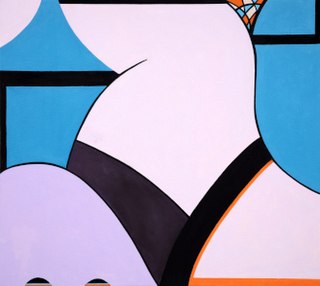
Amanda Church is an American artist known for abstract paintings that reference the human figure and other discernible elements. Her works straddle representational and formalist art traditions, suggesting recognizable body parts, objects, and perspectival elements in an otherwise abstract field. Church's distinctive use of contrasting style elements has been consistently noted by critics such as Hyperallergic's Cora Fisher, who described Church's work as "whimsically overruling the left-right brain dichotomy as well as the traditionally gendered axis that divides geometric and decorative art." Church received a Guggenheim Fellowship in 2015 and a Pollock-Krasner Foundation grant in 2017, among other awards. Her work has been covered in publications such as The New York Times, The Boston Globe, ARTnews, Hyperallergic and Forbes Magazine. Her paintings have been exhibited in major U.S. cities as well as internationally, in galleries and museums such as the Brooklyn Museum of Art and the Aldrich Museum. She lives and works in New York.
Gendai Bijutsu Kondankai was a study and discussion group founded in 1952 to facilitate interdisciplinary and cross-genre exchanges among Japanese artists based in the Kansai region. Among the participants were key figures of Japanese avant-garde art after World War II, such as calligraphers Shiryū Morita, Yuichi Inoue and Sōgen Eguchi, potter Yasuo Hayashi, and painters Waichi Tsutaka, Kokuta Suda, Jirō Yoshihara and future members of the Gutai Art Association. Genbi's activities, which included monthly meetings and group exhibitions, ceased in 1957.



















